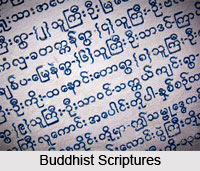 Language of Buddhist scriptures is perhaps a secured topic in Indian ancient history that had froze itself in the immortal cannons in Theravada Buddhism. Language had always seized prime position during Gautama Buddha`s times, on which He was believed to have laid special stress. Now, one of the most predominant features of Buddhism is that it propagates the most profound religious discourses in layman`s language. The medium in which Buddha preached was the common man`s language, Pali. However, there also exists a difference that Gautama Buddha was of the habit to preach in Magadhi, the ancient language of Magadha, which was later translated as Pali. Whatever was the case, Buddha wished that his followers know and realise the scriptures properly, so that they too can impart and transmit the knowledge of the holy texts with precision. Buddha also emphasised the need to be fluent with languages. According to him, it was only a wise man and good orator who possessed the capability to become a teacher. Language thus played an important role in extending the principles of Buddhism to people from all walks of life. In later eras, precisely after Buddha`s passing away into mahaparinirvana, when Buddhist schools started to divide amongst themselves, the Pali Canon which came into existence had particularly redefined language in Buddhist scriptures. Pali is the name given to the language of the scriptures (Pali canon) of Theravada Buddhism. Although Theravada tradition avows that the language of the canon is Magadhi, the language spoken by Gautama Buddha. The term Pali originally pertained to a canonical text or passage. The Pali language of the Theravadin canon is a version of a dialect of Middle Indo-Aryan, produced by an amalgamation of the dialects in which the teachings of Buddha were orally recorded and transmitted.
Language of Buddhist scriptures is perhaps a secured topic in Indian ancient history that had froze itself in the immortal cannons in Theravada Buddhism. Language had always seized prime position during Gautama Buddha`s times, on which He was believed to have laid special stress. Now, one of the most predominant features of Buddhism is that it propagates the most profound religious discourses in layman`s language. The medium in which Buddha preached was the common man`s language, Pali. However, there also exists a difference that Gautama Buddha was of the habit to preach in Magadhi, the ancient language of Magadha, which was later translated as Pali. Whatever was the case, Buddha wished that his followers know and realise the scriptures properly, so that they too can impart and transmit the knowledge of the holy texts with precision. Buddha also emphasised the need to be fluent with languages. According to him, it was only a wise man and good orator who possessed the capability to become a teacher. Language thus played an important role in extending the principles of Buddhism to people from all walks of life. In later eras, precisely after Buddha`s passing away into mahaparinirvana, when Buddhist schools started to divide amongst themselves, the Pali Canon which came into existence had particularly redefined language in Buddhist scriptures. Pali is the name given to the language of the scriptures (Pali canon) of Theravada Buddhism. Although Theravada tradition avows that the language of the canon is Magadhi, the language spoken by Gautama Buddha. The term Pali originally pertained to a canonical text or passage. The Pali language of the Theravadin canon is a version of a dialect of Middle Indo-Aryan, produced by an amalgamation of the dialects in which the teachings of Buddha were orally recorded and transmitted.
The Sinhalese tradition states that the Theravadin canon was penned down in the first century B.C.E. The language of the Pali Canon continued to be an enigma to the commentators and grammarians. They, on the other hand began to influence the Canon by their usage of language and by the native languages of the countries in which Theravada Buddhism became installed over many centuries. The oral transmission of Pali Canon continued for several centuries after the death of Buddha, even after the texts were first preserved in writing. No single script was ever formulated for the language of the canon; scribblers used the scripts of their native languages to transcribe the texts. As a result, language of Buddhist scriptures perhaps turned into a convoluted one, owing to additions of later populace. Although monasteries in South India are known to have been significant centres of Buddhist learning in the early part of this millennium, no manuscripts from anywhere in India except Nepal have outlasted. Almost all the manuscripts available to scholars can be dated back to the 18th or 19th centuries C.E. The pattern of recitation and substantiation of texts by councils of monks has remained well into the 20th century.
In the panoptic context of language of Buddhist scriptures, Gautama Buddha was always against the view that Sanskrit is superior to all other languages. As a result, all the ancient Buddhist manuscripts were scripted in Pali. Though Buddha himself preached in Pali, scholars and monks were encouraged to disseminate the message in regional languages. Pali is considered to be the principal medium of language for Buddhists. The scriptures of early Buddhist texts as well as those of Theravada Buddhism have been penned down in Pali. But when it came to preaching the Buddha marga (way of life), colloquial languages invariably came to usage. Four methods were adopted by Buddha to preach the principles propagated by him. He was a staunch supporter of regional dialects. He said to his disciples, "I allow you, O monk, to learn the word of Buddha each in his own language." In this way, Buddha fundamentally stands out from the other religious gurus.
Language thus held a special place in Buddhism. Buddha`s policy also made his discipline popular with the common man who hardly understood Sanskrit. Language was also instrumental in attaining nirvana in Buddhism, further heightened and enlightened by language in Buddhist scriptures.




